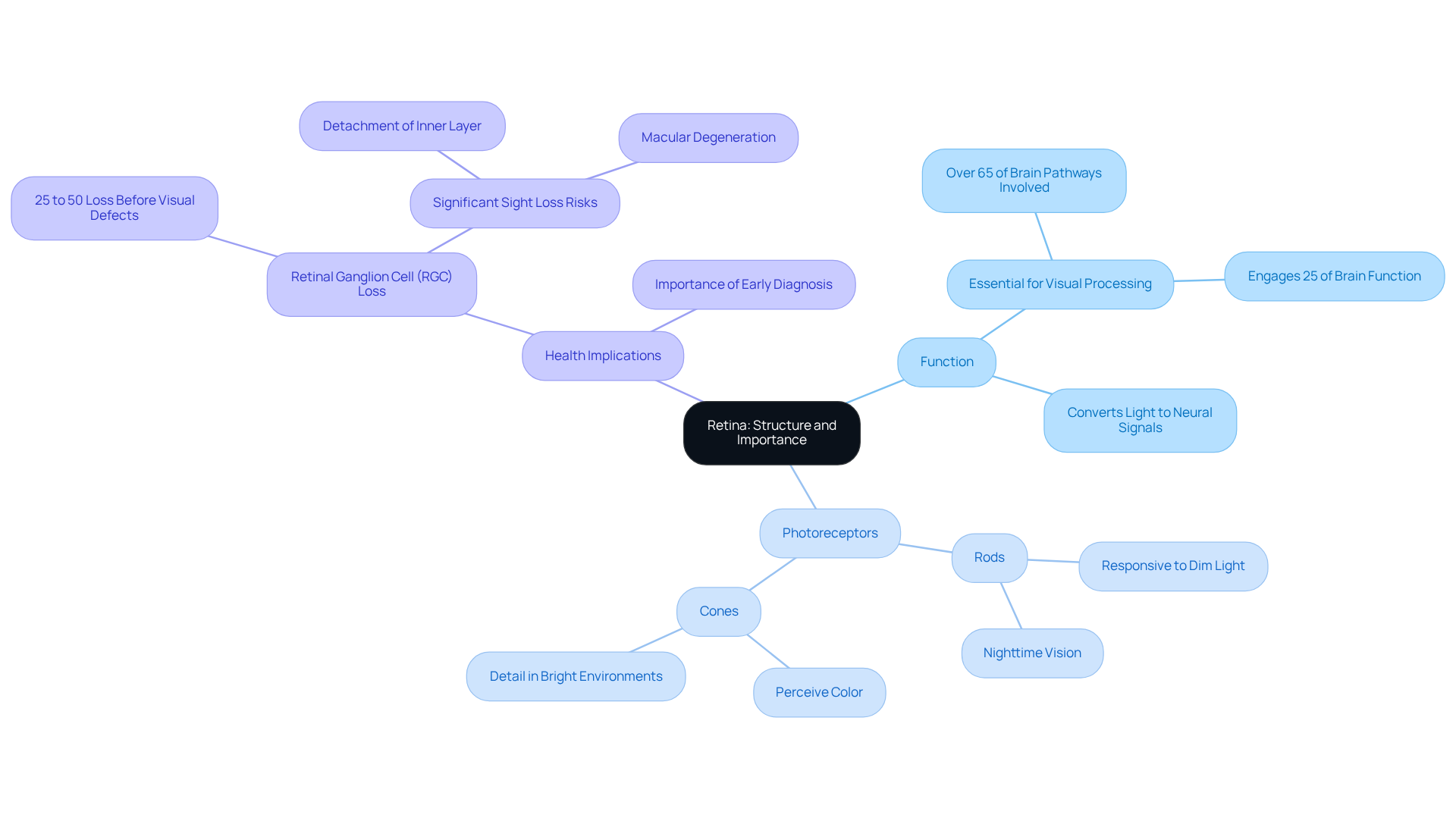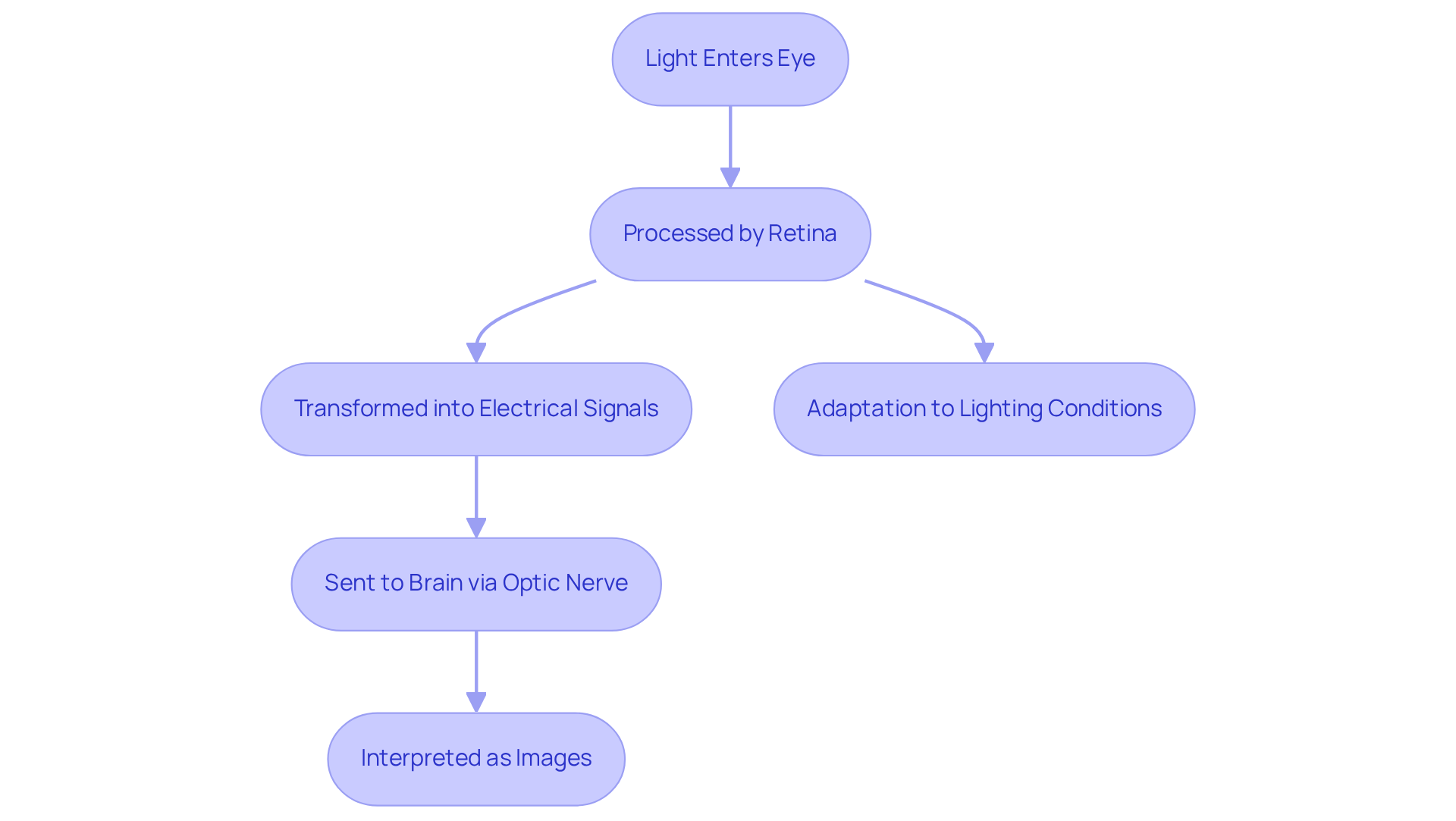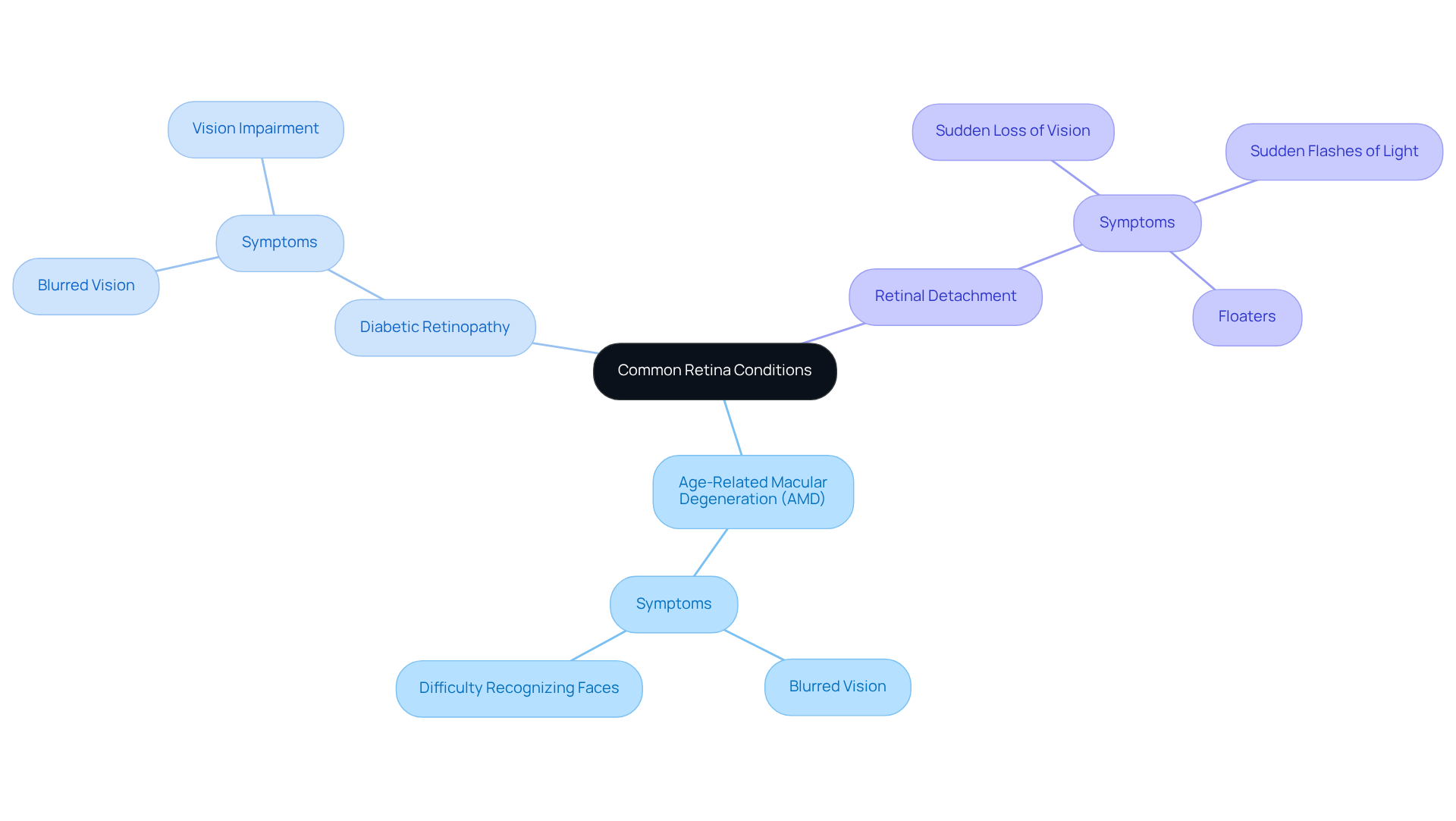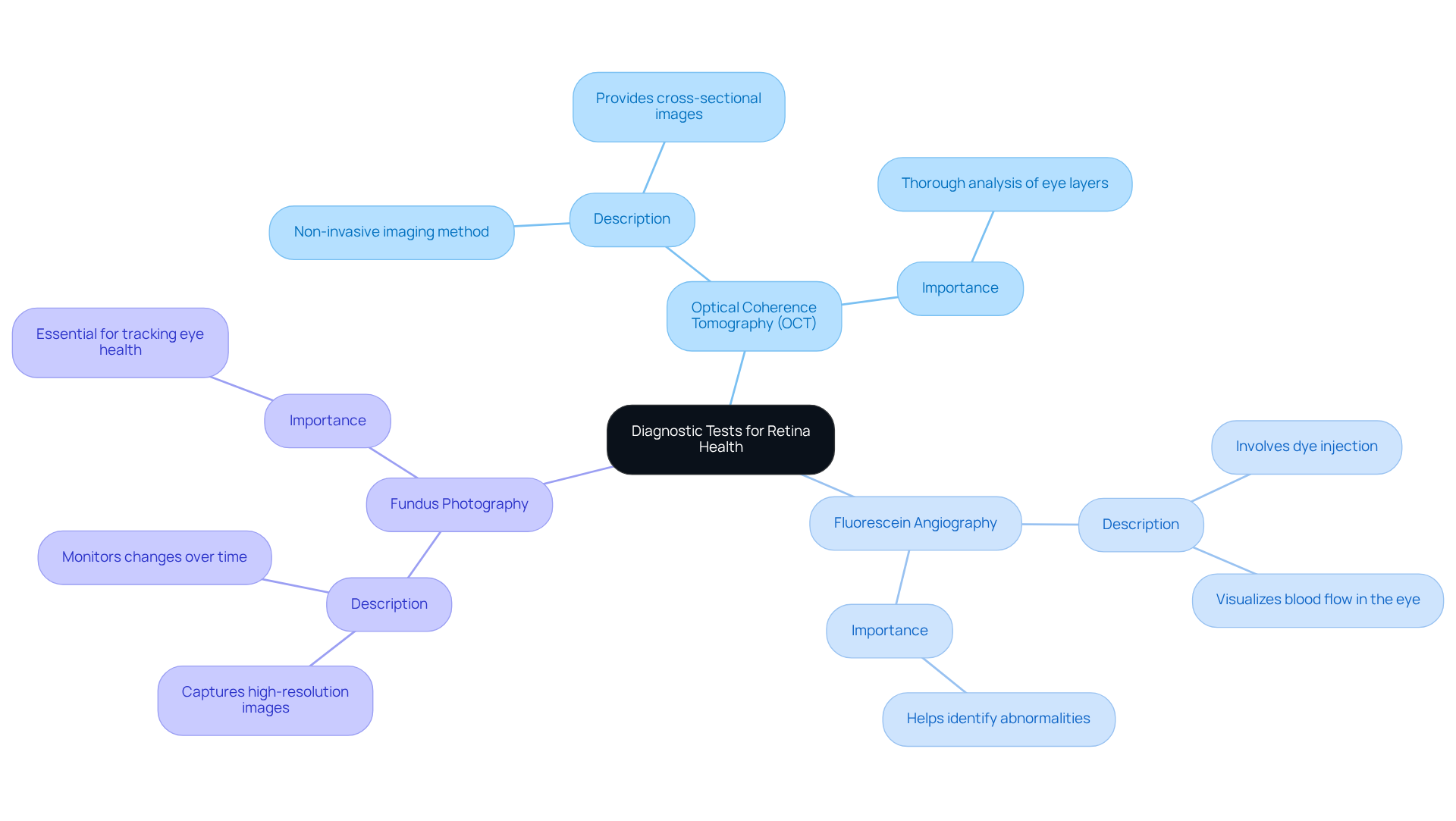Posted by: Northwest Eye in General on July 4, 2025
Overview
This article explores the essential functions of the retina, common conditions that can affect it, and helpful strategies for maintaining its health. We understand that the retina plays a critical role in vision, as it converts light into neural signals. It’s common to feel concerned about issues like age-related macular degeneration or diabetic retinopathy. Early detection and care are vital, and we are here to support you in navigating these challenges.
Diagnostic tests and lifestyle strategies can promote eye health, giving you the reassurance you need. Remember, taking proactive steps can make a significant difference in your vision and overall well-being.
Introduction
The retina, a delicate yet vital layer at the back of your eye, plays an essential role in transforming light into the visual images that shape how you perceive the world around you. We understand that learning about its functions can feel overwhelming, but it is crucial to recognize that any disruption to this tissue can lead to serious conditions threatening your eyesight.
Alarming statistics show that significant retinal damage can occur before symptoms appear, highlighting the urgency of proactive eye care. How can you safeguard your vision and maintain the health of this essential tissue amidst growing concerns about retinal diseases? We are here to help you through this process.
Define the Retina: Structure and Importance
The light-sensitive membrane is a delicate layer of tissue located at the back of your eye. It consists of various layers of neurons and photoreceptor cells. Its primary function is to convert light into neural signals, which your brain interprets as images. This tissue contains two crucial types of photoreceptors:
- Rods, which are very responsive to dim light and help with nighttime sight
- Cones, which perceive color and fine detail in bright environments
We understand that the complexity of the eye’s inner layer can be concerning. It’s important to know that any harm to this stratum can lead to significant sight loss, manifesting in issues such as detachment of the inner layer and macular degeneration. Statistics show that over 65% of all brain pathways are involved in visual processing, highlighting the eye’s essential role in overall function.
It’s common to feel anxious about eye health, especially with recent research indicating that retinal ganglion cell (RGC) loss may occur before visual field defects are detected. Early diagnosis and intervention are vital in maintaining your sight. Specifically, at least 25% to 50% of RGCs must be lost before significant visual field defects appear on automated perimetry testing.
The health of your eye’s inner layer is paramount. We are here to help you through this process, making it a and treatment strategies.

Explore Retina Functions: How It Affects Vision
The light-sensitive tissue in your eyes plays a vital role in your ability to see. It processes the light that enters your eye and transforms it into electrical signals. These signals are then sent to your brain through the optic nerve, where they are interpreted as images. We understand that being able to is essential for everyday activities, such as reading, driving, and recognizing faces.
Moreover, this light-sensitive layer helps your eyes adapt to different lighting conditions, allowing you to see clearly whether it’s bright or dim. It’s common to feel concerned about your vision, especially if you notice any changes. Remember, any dysfunction in the retina can lead to visual disturbances, which is why regular eye examinations are so important. They help monitor the health of your eyes and ensure you maintain your vision for all the things you love to do.

Identify Common Retina Conditions: Symptoms and Risks
Common retinal disorders, such as age-related macular degeneration (AMD), diabetic retinopathy, and retinal detachment, can be concerning for the retina eye. It’s important to recognize that symptoms may vary, but they often include:
We understand that AMD primarily affects central vision, making it challenging to read or recognize faces, which can be distressing. Diabetic retinopathy may lead to vision impairment due to damage to the retina eye’s blood vessels, while retinal detachment can result in a sudden loss of vision, requiring immediate medical attention. Understanding these conditions and their symptoms is crucial for early detection and treatment. We want to reassure you that can significantly improve outcomes and help you navigate these challenges.

Understand Diagnostic Tests: Assessing Retina Health
We understand that concerns about your can be daunting. Several diagnostic tests are available to assess the health of the retina eye, including:
- Optical coherence tomography (OCT)
- Fluorescein angiography
- Fundus photography
OCT is a non-invasive imaging method that provides cross-sectional images of the eye’s interior, allowing for a thorough analysis of its layers.
Fluorescein angiography involves injecting a dye into the bloodstream to visualize blood flow in the eye, which helps identify any abnormalities. Fundus photography captures high-resolution images of the retina eye, allowing doctors to monitor changes over time.
It’s common to feel anxious about these procedures, but routine eye examinations that include these tests are crucial for identifying eye problems early. This ensures that you receive prompt intervention and care. Remember, we are here to help you through this process and support you in maintaining your eye health.

Implement Care Strategies: Maintaining Retina Health
We understand that maintaining eye health is a priority for many individuals. To support you in this journey, it’s essential to adopt several lifestyle strategies. are not just a routine; they are vital for the early detection of potential issues, providing peace of mind.
A balanced diet can play a significant role in promoting eye health. Foods rich in antioxidants, vitamins C and E, and omega-3 fatty acids are particularly beneficial. Consider incorporating the following into your meals to nourish your eyes:
- Leafy greens
- Fish
- Nuts
Moreover, safeguarding your eyes from damaging UV rays is crucial. Wearing sunglasses and avoiding smoking can greatly lessen the chance of developing eye disorders. We know that staying active and managing chronic conditions like diabetes and hypertension are also important steps in preserving your vision.
By implementing these strategies, you can help protect and enhance your overall quality of life. Remember, we are here to help you through this process.
Conclusion
The retina is a vital part of your eye health, acting as the light-sensitive layer that transforms light into visual signals our brains interpret as images. We understand that recognizing its structure and functions is essential for appreciating the importance of maintaining retinal health and addressing potential issues that may arise.
In this article, we have explored various aspects of retinal health, including common conditions such as:
- Age-related macular degeneration
- Diabetic retinopathy
- Retinal detachment
We discussed their symptoms and risks. We highlighted diagnostic tests like:
- Optical coherence tomography
- Fluorescein angiography
as crucial tools for early detection and intervention. Moreover, we emphasized practical care strategies, including:
- Regular eye exams
- A balanced diet rich in antioxidants
- Protective measures against UV rays
as critical steps in preserving your vision.
Ultimately, prioritizing your eye health is integral to your overall well-being. By being proactive in monitoring retinal conditions and adopting healthy lifestyle choices, you can significantly reduce the risk of vision impairment. Embracing these strategies not only enhances your quality of life but also fosters a deeper appreciation for the vital role that the retina plays in your everyday activities. Remember, taking action today can ensure a clearer tomorrow.
Frequently Asked Questions
What is the retina and where is it located?
The retina is a light-sensitive membrane located at the back of the eye. It consists of various layers of neurons and photoreceptor cells.
What are the primary functions of the retina?
The primary function of the retina is to convert light into neural signals, which are interpreted by the brain as images. It also helps the eyes adapt to different lighting conditions.
What types of photoreceptors are found in the retina?
The retina contains two crucial types of photoreceptors: rods, which are responsive to dim light and assist with nighttime vision, and cones, which perceive color and fine detail in bright environments.
Why is the health of the retina important?
The health of the retina is essential because any harm to this layer can lead to significant sight loss, including issues such as detachment and macular degeneration.
What percentage of brain pathways are involved in visual processing?
Over 65% of all brain pathways are involved in visual processing, highlighting the retina’s essential role in overall function.
What is the significance of early diagnosis regarding retinal health?
Early diagnosis is vital because retinal ganglion cell (RGC) loss can occur before visual field defects are detected. At least 25% to 50% of RGCs must be lost before significant visual field defects appear on testing.
How does the retina affect everyday activities?
The retina is crucial for perceiving light and color, which are essential for activities such as reading, driving, and recognizing faces.
Why are regular eye examinations important?
Regular eye examinations are important to monitor the health of the retina and ensure that any dysfunction is detected early, helping to maintain vision for daily activities.






